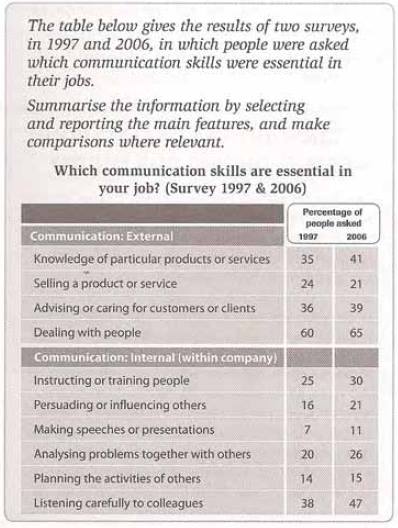The table chart compares the proportion of communication competencies which are crucial in occupation as per the opinion of respondents on surveys in 1997 and 2007. Overall, it can be analyzed that the sequences of skills from the most important to the lowest in both of survey in 1997 and 2006 remained unchanged. In any case, dealing with people was the most important skills in a job, while conducting presentation was assumed as an unessential expertise in a profession.
To begin, the survey in 1997 reveals that being faced with other people, listening to colleagues, advising for a client, knowing of products and training people were the top five crucial skills which the percentage reached of 60, 38, 36, 35 and 25 percent consecutively. Interestingly, these competencies, based on the survey in 2006, were still in the top five though there was an alteration formation between caring for costumers and knowing of a particular product.
On the other hand, the five remaining skills such as analyzing work together with others, selling a product, persuading others, planning the activities of others, and making a presentation were valued by respondent as the five lowest necessities in job which based on the current study showed that the rates realized at fewer than 26%, while in the oldest survey gained at just under 24%.
To begin, the survey in 1997 reveals that being faced with other people, listening to colleagues, advising for a client, knowing of products and training people were the top five crucial skills which the percentage reached of 60, 38, 36, 35 and 25 percent consecutively. Interestingly, these competencies, based on the survey in 2006, were still in the top five though there was an alteration formation between caring for costumers and knowing of a particular product.
On the other hand, the five remaining skills such as analyzing work together with others, selling a product, persuading others, planning the activities of others, and making a presentation were valued by respondent as the five lowest necessities in job which based on the current study showed that the rates realized at fewer than 26%, while in the oldest survey gained at just under 24%.

12540593_11978050602.jpg
